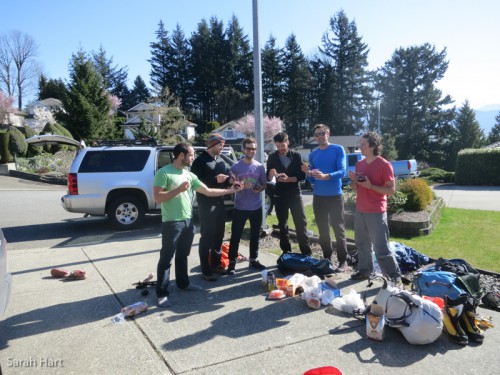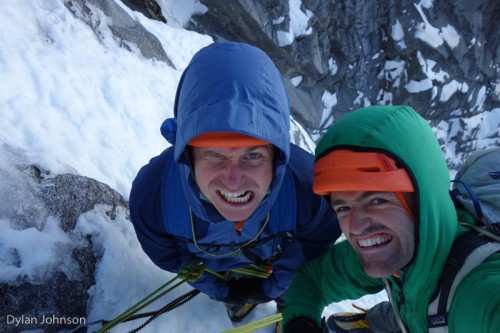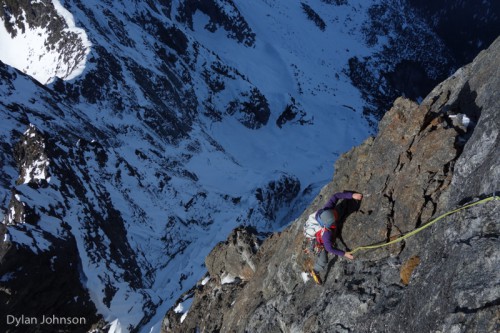I’m breaking with chronological order for once – publishing these reports from winter climbing in the Cascades while I still finish writing up a juggernaut of a blog post about my Patagonia season.
Colfax Peak
Upon getting home from Patagonia on March 1st, I spent a few days jetlagged in Seattle, dealing with the various life chores that accumulate when you’ve left the continent for four months. Normally skiing would’ve been my top priority, since missing the majority of the ski season is the biggest downside to Patagonian climbing for me, but this winter there is such a pitiful amount of snow in the Cascades, that it didn’t seem urgent. After a few sluggish days I reenergized, and Sarah and I made some plans for the mountains.
Skiing and alpine climbing are very complimentary activities, and among the strongest reasons is that when one is in bad condition the other is usually in good condition. Winter alpine climbing in the Cascades was at one point the biggest focus in my climbing, and although I’ve been away from that pursuit for some time, I knew that conditions would be excellent. Like the last similar winter (2004-2005), a meagre snowpack, especially at lower elevation, meant that one could drive to many trailheads that require a lengthy ski approach to reach in normal winters. One of these trailheads is the Heliotrope Ridge trail, which gives access to the northwest side of Kulshan and the north side of Colfax Peak. Two years earlier Sarah and I had made an autumn attempt on Colfax Peak’s Polish Route, and although we were thwarted only one pitch up, I realized it was one of the highest quality alpine climbs around, and vowed to return.
Sarah and I made plans to attempt the Polish Route on March 6, and late the evening beforehand learned from my longtime friend Roger Strong that he and Doug Hutchinson were also planning an attempt for the same day. Roger told me that the route had seen its second ascent (and first complete ascent) only a few weeks earlier by Will Hinkley and Braden Down. Chamonix style then – Fifteen years with no ascents, and then multiple parties on one day!
After the invigorating approach, Sarah and I started up the route just after Roger and Doug. Conditions were massively better than our attempt two years earlier, and we arrived below the crux pitch after just a tricky bergschrund crossing, one long pitch of AI4+ and a short snow slope. Roger was kind enough to wait for us to be safely to the side before climbing onto the free-hanging dagger of the crux pitch.
Due to my Patagonia addiction I hadn’t gone waterfall climbing since 2006, and believe it or not, had never climbed a free-hanging dagger before. The actual moves of the crux pitch weren’t exceptionally difficult (but we all agreed it was WI6), but it definitely felt spooky climbing onto a piece of ice hanging delicately from the roof above. I thought it was awesome to be climbing what is probably the most difficult waterfall pitch I’ve ever climbed, not on any old waterfall, but way up in the alpine, thousands of feet above treeline, above expansive glaciers, and with awesome views the whole time of Salish Sea saltwater and the San Juan Islands. Sarah, having only ever been waterfall climbing once before, did an awesome job of climbing her first pitch of grade 6, way up in the mountains with a pack on!
The more time I spend on Colfax Peak the more I realize how awesome of a resource it is for western Washington ice and alpine climbers. The ice conditions are far more reliable than any other mountains I know of in the range (due, I think, to a combination of high elevation, north-facing aspect, and geothermal heat). In a normal winter the access isn’t so easy as right now, but there is usually a period in the autumn when the ice is already forming and the road is still drivable. Also, the rock is very well featured in terms of holds, and despite being volcanic is surprisingly solid. Cracks are sparse, but I think there is good potential for hard bolted mixed climbs if someone has the time and motivation to establish them.


















The Heart of Darkness
The evening after climbing the Polish Route, Sarah and I drove to Abbotsford to visit her aunt and uncle. The next morning I was picked up by my good friend and climbing partner, Dylan Johnson, along with four other friends: Andy Wyatt, Chris Potts, Will Hanson and James Tinker. Andy, Chris, Will and James were planning to climb Slesse by the west face, and Dylan and I were hoping to climb the Heart of Darkness on Slesse’s north side.
The Heart of Darkness is a very obvious feature – a giant gash that goes straight up, between the Northeast Buttress and North Rib. It’s been attempted by a lot of hardcore local climbers going back to at least the early ‘80s, including Peder Ourum, Perry Beckham, Greg Child, Joe Buszowski, Guy Edwards, John Millar and Jeremy Frimer (and quite likely others whom I’m not aware of). It even was once on the radar of Michael Kennedy and Jeff Lowe, which Michael told me about in an e-mail in 2009. For those who don’t know, this was in the immediate wake of Michael’s first ascents of both the Kennedy-Lowe on Begguya and Infinite Spur on Sultana (one of the most badass Alaska trips of all time):
“Jeff Lowe and I drove from Colorado to Seattle in 1977, then flew up to Alaska. After Jeff broke his ankle he shacked up with some honey in Anchorage while George and I went to Foraker. We had a little money and a few days left when we got back to Seattle, so Jeff convinced me to head up to Slesse for a look. As mentioned above I was a little wasted.
All I remember is driving up a logging road (I think it goes much further in now) then slogging for a very long way through the brush until we got into the valley below the face. With Jeff’s partially-healed ankle, the weather (not so appealing) and my almost-catatonic state, we didn’t have a chance. I think we spent the night but maybe not.”
For many years the highpoint on the Heart of Darkness had been reached by Guy Edwards, during an attempt with Jeremy Frimer. Several years ago, Dylan made an attempt with our mutual friend Roger Strong, and they matched Guy and Jeremy’s high point.
Ever since Mark Bunker and I succeeded on Mt. Stuart’s complete North Ridge in the winter of 2005, the Heart of Darkness has been my highest priority project in the Cascades. However, in the past decade I haven’t spent much time in the Cascades in general, and I never made a real attempt. Dylan and I drove to the trailhead a couple years ago with the Heart of Darkness on our minds, but realized immediately that we had come too late in the spring.
Hiking into the basin below Slesse’s east face, I could feel that my legs were a bit tired from climbing Colfax the day before, but it was obvious that conditions were exceptionally good. Before us we could see all the awesome attributes of winter climbing, such as more spectacular scenery and vegetation-free climbing, with none of the disadvantages, such as long approaches and deep snow wallowing. We hiked all the way to the memorial plaque on dry ground, and then crunched across the basin on firm snow. By contrast, my last visit to Slesse in the wintertime (in 2012 with Nick Elson), ended in meter-deep soft snow at the memorial plaque, having spent a long, hard day skiing from the Chilliwack Lake Road.
On March 8 our alarm malfunctioned, and we didn’t leave our tent in the basin until almost first light – An unintended late start, but we definitely both appreciated the extra sleep after several days of early wake-ups! We had a bit of trail-breaking on the way up to the start of the Heart of Darkness, but nothing in comparison to a normal winter. Dylan crossed the bergschrund and we started simul-climbing up the couloir at 8:20.
The Heart of Darkness has 3 distinct sections: a lower couloir, a crux section midway, and a upper couloir. Both the upper and lower couloirs we climbed as individual pitches of simul-climbing. Under more typical conditions they might’ve had some tricky bits, but in the exceptionally good conditions we encountered, the couloirs both had difficulties only to about AI3/AI4.
In the couloirs the exceptionally good conditions allowed us to move faster than we would have otherwise. In the crux section the excellent conditions made a much larger difference. On Dylan’s attempt with Roger, Roger led a pitch of M6R to their highpoint, which was estimated to be roughly the same as Guy Edwards’ high point. A pitch that turned back Guy Edwards must’ve been serious business. By contrast, on our ascent I led an 80m pitch of straightforward AI4 to past the previous highpoints – Conditions make all the difference in the world!
After the long AI4 pitch, I led a short, traversing pitch rightwards, to rejoin the gut of the HOD at the base of the upper couloir. This pitch involved some straightforward aid climbing to start, and I’ll even say that it was enjoyable aid climbing, pounding horizontal knifeblades into a traversing crack. When the pro ran out I had to make a few free-climbing moves on a balancy traverse (M5+), which felt spicy with a big overhang below, but a fall would’ve only been very scary, not dangerous. We were both blown away by how casually we had negotiated the crux. We had come expecting a very serious, very difficult battle through this section. Thanks to the exceptionally good conditions it was fun, fast, and never even scary.
For years of scheming about the Heart of Darkness, I always knew that I wouldn’t consider it complete without continuing to the summit of Slesse (On reaching the top of the North Couloir, it is very easy to bail down the west side). I always imagined difficult mixed climbing on the upper North Rib, and it was for exactly this reason that I climbed the North Rib in 2010 with Nick Elson, to learn what the terrain was like. Upon arriving at the col, however, we were delighted to find the upper North Rib almost entirely free of snow and ice. Dylan led these last four pitches, which we could climb bare-handed in the afternoon sun. What a conditions combo – Plentiful ice in the shady, north-facing couloir, followed by dry sun-warmed rock in the sun!
Our descent went very smoothly, with just two short rappels near the summit and a bunch of downclimbing. One slabby section on which in summertime I often make a short rappel we could easily downclimb on a nice fat flow of WI3. The crossover descent, which normally in winter would be a long, drawn-out affair of post-holing, was an enjoyable nevé scamper, with amazing views both back towards the north side of Slesse, and out to a sunset over the Fraser valley. Before long we were back at our tent, and a couple hours later back at the trailhead. Alpine climbing is often about timing, and in this instance ours was perfect. We did nothing better than the previous attempts other than deciding to go at the right moment, which fortunately occurred when we were available to take advantage of it. I certainly had enjoyed three of my best-ever climbing days in the Cascades!



























